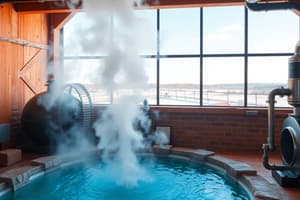Podcast
Questions and Answers
What is a key distinction between renewable and non-renewable energy sources?
What is a key distinction between renewable and non-renewable energy sources?
- Renewable energy sources can be replenished naturally within a human lifespan. (correct)
- Non-renewable energy sources are derived from living organisms only.
- Non-renewable energy sources are always more efficient than renewable sources.
- Renewable energy sources are finite and can be depleted over time.
Which of the following forms of fossil fuels is considered the least carbon-intensive?
Which of the following forms of fossil fuels is considered the least carbon-intensive?
- Peat
- Oil
- Natural Gas (correct)
- Coal
Which statement about geothermal energy is true?
Which statement about geothermal energy is true?
- Geothermal power plants can operate anywhere without geographical limitations.
- Geothermal energy has a higher operational risk compared to fossil fuels.
- Geothermal energy recovery requires minimal land use. (correct)
- Geothermal energy can only be harvested in volcanic regions.
What are the advantages commonly associated with geothermal power plants?
What are the advantages commonly associated with geothermal power plants?
Which of the following best exemplifies the types/ranks of coal?
Which of the following best exemplifies the types/ranks of coal?
Flashcards
Kinetic Energy
Kinetic Energy
Energy of motion.
Potential Energy
Potential Energy
Stored energy of position.
Renewable Energy
Renewable Energy
Energy sources that can be replenished naturally.
Fossil Fuel
Fossil Fuel
Signup and view all the flashcards
Geothermal Energy
Geothermal Energy
Signup and view all the flashcards
Study Notes
Energy Sources
- Energy sources are materials harnessed to produce energy
- Natural resources are naturally occurring materials usable for economic gain
- Energy is the ability to do work
Forms of Energy
- Kinetic Energy: Energy of movement (mechanical, sound, light, heat, electrical)
- Potential Energy: Stored energy due to position, properties, and forces (gravitational, elastic)
Laws of Thermodynamics
- 1st Law: Energy cannot be created or destroyed, only transformed
- Energy can change from one form to another. There are two categories of Energy Resources
- Renewable Energy Sources: Derived from natural processes continually replenished.
- Non-renewable Energy Sources: Finite and deplete over time
Department of Energy (DOE)
- The executive department of the Philippine government responsible for energy planning, coordination, supervision, and control.
National Grid Corporation of the Philippines (NGCP)
- A private corporation established in 2009 (RA 9511)
- Manages, maintains, and transmits electricity
Renewable Energy
- Solar Energy: Energy from the sun
- Wind Energy: Uses wind turbines to generate electricity
- Hydroelectric Energy: Converts falling water energy into electricity
- Geothermal Energy: Uses Earth's internal heat
- Bioenergy: Organic materials (biomass) from plants and animals
Non-renewable Energy
- Fossil Fuels: Organic materials buried in rock (coal, oil, natural gas)
- Nuclear Energy: Energy released from splitting atoms (uranium, plutonium)
Fossil Fuels
- Coal: A sedimentary rock primarily composed of carbon, hydrogen, sulfur, oxygen, and nitrogen. Coal is formed by the process of coalification.
- Natural Gas: A colorless and odorless compound primarily methane.
- Oil (Petroleum): A black, thick, and mushy liquid found between rock layers
- Fossil Fuels can be found in the form of coal, oil, or natural gas
- Coal is also categorized as a rank. Ranks include lignite, bituminous, and anthracite
- Fossil fuels are formed from organic matter buried in rocks; these materials undergo changes through metamorphism.
Extraction Methods
- Coal: Surface/underground mining
- Petroleum: On-land/offshore drilling
- Natural Gas: Drilling, and transport through pipelines
Geothermal Energy
- Geothermal energy is the internal heat energy from the Earth. Geothermal energy comes from the Earth's internal heat and radioactive decay.
- Sources include hot springs, and geysers, which can be harnessed to produce energy.
- Geothermal reservoirs are naturally occurring or man-made aquifers with hot water/steam. This heat/water comes from deep within the Earth
Studying That Suits You
Use AI to generate personalized quizzes and flashcards to suit your learning preferences.





